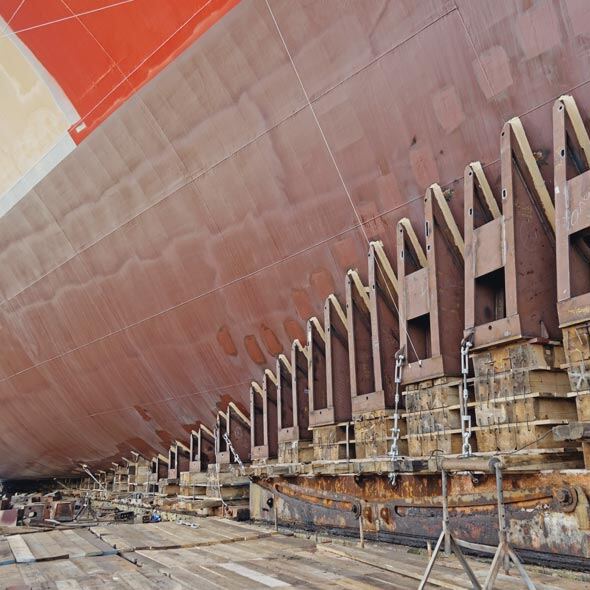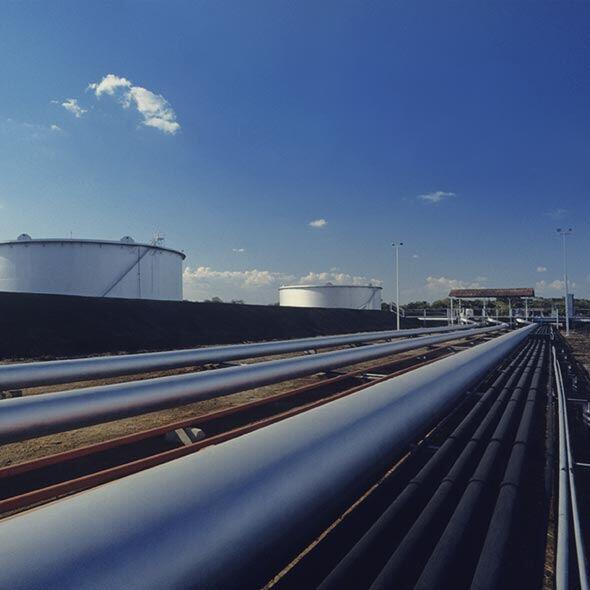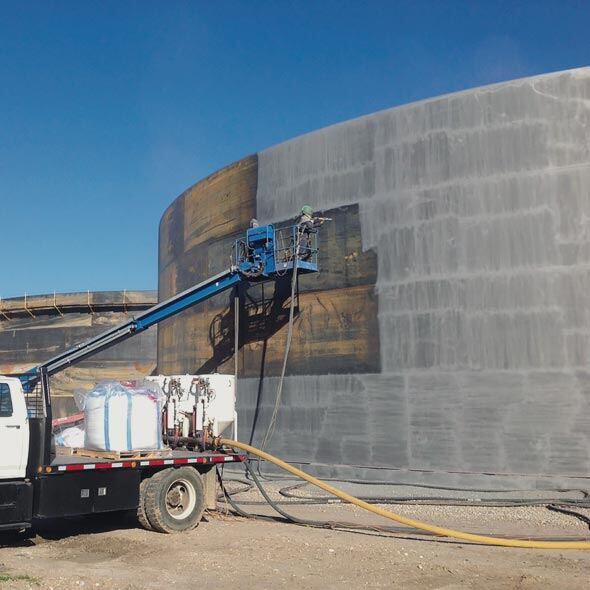You’re currently viewing the Americas website.
You’re currently viewing the Americas website.
Would you like to switch countries or language?Blast Abrasives
Topics
Waterjet Cutting
Topics
Resources
Categories
Types
Categories
Topics
Abrasive Blasting Tech Tips English Global-2-2-min.png)
Abrasive Blasting Media Guide: How to Select the Right Garnet Abrasive
And Seven Types of Jobs That Benefit from a Finer Garnet Grade
Want to increase your blasting efficiency? Check whether you are using the correct garnet grain size to achieve your desired surface profile.
Many blasting and coating specialists default to using a 30/60 mesh garnet abrasive or a coarser garnet for surface cleaning and preparation. However, the size of the abrasive particles can significantly influence surface cleaning rates because the number of grains in standard garnet grades can vary from four to 13 million per kilogram.
Your Abrasive Blasting Media Guide: Practical Considerations
- Optimal blasting performance is achieved by matching the correct garnet grain size for the specific job with clean, dry compressed air at the appropriate pressure in conjunction with controlled abrasive flow rates.
- You can facilitate efficient paint application by having a uniform surface profile without rogue peaks or oversized troughs.
- The unique physical nature of garnet being sharp, hard and tough allows usage at lower air pressures, avoiding over-blasting or unnecessary damage to the substrate.
Why Use a Finer Garnet Abrasive?
When blasting, larger garnet grains facilitate deeper indentations than finer garnet grains but produce fewer impacts across any given area. This is due to fewer grains hitting the surface area per square foot. The use of a finer grade with a higher grain count per kilogram will produce more impacts per square foot, resulting in more efficient blasting performance on lightly rusted coatings, mill scale and heavy corrosion.
In addition to higher blasting rates, finer garnet grains produce a more uniform surface profile, cleaner finish and higher peak density. They also can sweep out rust within tight crevices.
Coarser vs. Finer Garnet Grains on a Coated Metal
-3-2.png)
How to Select the Right Garnet Blasting Media
Depending on your required finish, there is an ideal garnet grain size for your job. Here's what to know.
- Consider your application. For general applications when a surface profile above 75 microns is specified, the 30/60 mesh garnet abrasive is the ideal industry standard garnet grade. Finer garnet grades range from 80 to 120 mesh, and ultra-fine garnet grades range from 200 to 300 mesh size.
- Most importantly, determine the physical nature of the required finish (i.e. surface profile and standard of cleanliness). For example, when surface profiles above 75 microns are required, a relatively coarse garnet may be appropriate. However, most of the time, the purpose of blast cleaning is not to simply aggressively attack the surface. Make sure you can achieve the required surface profile without unduly exceeding the surface preparation requirement.
When to Use Finer Grades of Garnet
Finer grain garnet has the versatility to achieve desired results for specialized applications by reducing the potential of undue damage to work pieces. Using finer grains at the appropriate nozzle pressure facilitates control and efficiency.
Sweep Blasting
This process can prepare structures where an existing coating has deteriorated or a recently blasted surface has flash rusted. Intact paintwork needs to be brush blasted to remove loose paint, contamination and produce a surface profile for subsequent recoating. Any corroded areas also require blast cleaning to a specified standard. A smaller garnet grain abrasive will effectively etch the intact coating, while scouring into any existing surface profile on the exposed substrate, enabling the original profile to be efficiently reserviced for the new coating. It also facilitates a feathered transition between intact coating and bare steel.

General Maintenance
Blasting with a finer grade garnet is beneficial when you have low-build coatings or heavily pitted surfaces. Using a finer grade garnet on low build coating systems results in a faster blast with more particles impacting the surface per square foot. In the case of heavily pitted surfaces, finer garnet particles are able to fit into pitted areas to clean where coarser particles cannot. Therefore, using a finer garnet grade can prevent premature coating failure due to substandard cleanliness. Furthermore, as garnet is an abrasive that generates minimal levels of dust, it facilitates efficient surface preparation without undue contamination of surrounding areas.
Architectural Concrete
To achieve a quality and uniform finish, it is essential to use a finer grade garnet to ensure the specified finish is obtained. Often, using a coarser abrasive can result in over-blasting that can produce an unacceptable surface finish. Once that happens, there is no going back.
Aluminum Structures and Galvanized Surfaces
The scouring effect of smaller grains can serve to clean away contamination from surface undulations. Lower air pressure will avoid undue damage to relatively soft surfaces.

Fiberglass
Repairs to fiberglass surfaces often require removal of top layers of resin without causing damage to the gel coat. Smaller garnet grains will facilitate controlled surface preparation, localized repairs and create the desired feathering effect onto the intact resin.
Graffiti Removal
Graffiti removal will often need to be repeated on regular occasions. Hence, the ability to do the job without undue damage to the substrate is invaluable. The use of a finer grain garnet gives the blaster greater control and helps wear away unwanted decoration without ripping into the surface.
Turbines and Propellers
Even the finest grade of garnet remains a hard, sharp tool. When turbines and propellers become encrusted with detritus, you can use ultra-fine garnet at controlled pressures for brush blasting without affecting the dynamics of the work piece.
Selecting the smallest particle size required to achieve the desired result will reduce the need to paint over rogue peaks or fill oversized troughs within the surface profile.
When to Use Larger Garnet Sizes
The range of particle sizes available within different grades garnets and the garnet performing at variable pressures combine to achieve a variety of finishes according to specific requirements. However, garnet performance is determined by the virtue of energy produced by velocity. When you remove thick, soft coatings, the surface may absorb the energy before the garnet grains achieve full impact potential. Therefore, the heavier features of larger grain garnet can be more effective. Equally, when blasting off high build coatings above 500 microns in thickness and with heavy corrosion on ship hulls, finer garnet grains may not perform as well.

In summary
The physical nature of finer grade garnet facilitates better blasting performance. Finer garnet grades can enable more controlled blasting, more efficient blasting performance and cleaner surface profiles up to 75 microns.
You can remove certain surface coatings such as mill scale, light rust and low build coatings more effectively with finer grade garnet. Specialized finishes on applications like graffiti removal, fiberglass and flash blasting are possible by the combination of finer grains and variable air pressure.
Selecting the smallest particle size required to achieve the desired result will reduce the need to paint over rogue peaks or fill oversized troughs within the surface profile.
Call in an Expert
Sometimes, it's best to consult a garnet expert in your planning stage of the project to obtain the right garnet blasting media for your desired profile. This can result in increasing blasting rates by more than 10% and reducing the volume of abrasive used by up to 10%, resulting in shorter project times and lower cost.
Ready to begin? Talk to a GMA expert about the abrasive that's right for your application.
 GMA ToughBlast™
GMA ToughBlast™ GMA SpeedBlast™
GMA SpeedBlast™ GMA NewSteel™
GMA NewSteel™ Oil & Gas
Oil & Gas Industrial Fabrication & Maintenance
Industrial Fabrication & Maintenance Marine & Ship Building
Marine & Ship Building TruCost Blast Calculator
TruCost Blast Calculator Product Selector
Product Selector Brochure | GMA Garnet Blast Abrasives
Brochure | GMA Garnet Blast Abrasives News: GMA's Roadmap to Sustainability
News: GMA's Roadmap to Sustainability GMA ExcelCut
GMA ExcelCut GMA ProCut™
GMA ProCut™ GMA ClassicCut™
GMA ClassicCut™ Metal fabrication
Metal fabrication Glass cutting
Glass cutting Stone cutting
Stone cutting Case Study | GMA ClassicCut | Smith and Nephew
Case Study | GMA ClassicCut | Smith and Nephew Why is Garnet the preferred abrasive in Waterjet cutting?
Why is Garnet the preferred abrasive in Waterjet cutting? Water Filtration
Water Filtration Rubber Fillers
Rubber Fillers Anti-skid Products
Anti-skid Products Ilmenite Sand
Ilmenite Sand Pyroxene
Pyroxene Rutile
Rutile